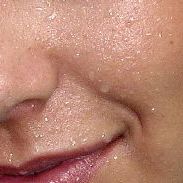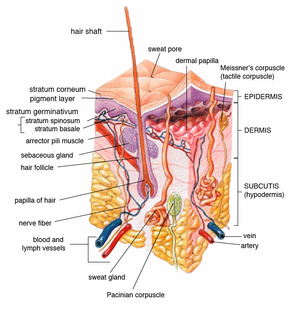
Perspiration, also known as sweating, is the production of fluids secreted by the sweat glands in the skin of mammals.

A lipoma is a benign tumor made of fat tissue. They are generally soft to the touch, movable, and painless. They usually occur just under the skin, but occasionally may be deeper. Most are less than 5 cm in size. Common locations include upper back, shoulders, and abdomen. It is possible to have a number of lipomas.

A sebaceous gland is a microscopic exocrine gland in the skin that opens into a hair follicle to secrete an oily or waxy matter, called sebum, which lubricates the hair and skin of mammals. In humans, sebaceous glands occur in the greatest number on the face and scalp, but also on all parts of the skin except the palms of the hands and soles of the feet. In the eyelids, meibomian glands, also called tarsal glands, are a type of sebaceous gland that secrete a special type of sebum into tears. Surrounding the female nipple, areolar glands are specialized sebaceous glands for lubricating the nipple. Fordyce spots are benign, visible, sebaceous glands found usually on the lips, gums and inner cheeks, and genitals.

Hidradenitis suppurativa (HS), sometimes known as acne inversa or Verneuil's disease, is a long-term dermatological condition characterized by the occurrence of inflamed and swollen lumps. These are typically painful and break open, releasing fluid or pus. The areas most commonly affected are the underarms, under the breasts, and the groin. Scar tissue remains after healing. HS may significantly limit many everyday activities, for instance, walking, hugging, moving, and sitting down. Sitting disability may occur in patients with lesions in sacral, gluteal, perineal, femoral, groin or genital regions; and prolonged periods of sitting down itself can also worsen the condition of the skin of these patients.

The dermis or corium is a layer of skin between the epidermis and subcutaneous tissues, that primarily consists of dense irregular connective tissue and cushions the body from stress and strain. It is divided into two layers, the superficial area adjacent to the epidermis called the papillary region and a deep thicker area known as the reticular dermis. The dermis is tightly connected to the epidermis through a basement membrane. Structural components of the dermis are collagen, elastic fibers, and extrafibrillar matrix. It also contains mechanoreceptors that provide the sense of touch and thermoreceptors that provide the sense of heat. In addition, hair follicles, sweat glands, sebaceous glands, apocrine glands, lymphatic vessels, nerves and blood vessels are present in the dermis. Those blood vessels provide nourishment and waste removal for both dermal and epidermal cells.
Body odor is present in all animals, including humans, and its intensity can be influenced by many factors. Body odor has a strong genetic basis, but can also be strongly influenced by various diseases and physiological conditions. Though body odor has played an important role in early humankind, it is generally considered to be an unpleasant odor amongst many human cultures.

Hyperhidrosis is a condition characterized by abnormally increased sweating, in excess of that required for regulation of body temperature. Although primarily a physical burden, hyperhidrosis can deteriorate quality of life from a psychological, emotional, and social perspective. This excess of sweat happens even if the person is not engaging in tasks that require muscular effort, and it does not depend on the exposure to heat. Common places to sweat can include underarms, face, neck, back, groin, feet, and hands. It has been called by some 'the silent handicap'.

Sweat glands, also known as sudoriferous or sudoriparous glands, from Latin sudor 'sweat', are small tubular structures of the skin that produce sweat. Sweat glands are a type of exocrine gland, which are glands that produce and secrete substances onto an epithelial surface by way of a duct. There are two main types of sweat glands that differ in their structure, function, secretory product, mechanism of excretion, anatomic distribution, and distribution across species:

Meleda disease (MDM) or "mal de Meleda", also called Mljet disease, keratosis palmoplantaris and transgradiens of Siemens, is an extremely rare autosomal recessive congenital skin disorder in which dry, thick patches of skin develop on the soles of the hands and feet, a condition known as palmoplantar hyperkeratosis. Meleda Disease is a skin condition which usually can be identified not long after birth. This is a genetic condition but it is very rare. The hands and feet usually are the first to show signs of the disease but the disease can advance to other parts of the body. Signs of the disease include thickening of the skin, on hands and soles of feet, which can turn red in color. There currently is no cure and treatment is limited, but Acitretin can be used in severe cases.
Aquagenic pruritus is a skin condition characterized by the development of severe, intense, prickling-like epidermal itching without observable skin lesions and evoked by contact with water.

Hidradenoma refers to a benign adnexal tumor of the apical sweat gland. These are 1–3 cm translucent blue cystic nodules. It usually presents as a single, small skin-colored lesion, and is considered distinct from the closely related poroma. Hidradenomas are often sub-classified based on subtle histologic differences, for example:

Trichobacteriosis axillaris is a superficial bacterial colonization of the hair shafts in sweat gland–bearing areas, such as the armpits and the groin. It is a trivial disease of worldwide occurrence that is believed to be caused by the genus Corynebacteria.

Merocrine is a term used to classify exocrine glands and their secretions in the study of histology. A cell is classified as merocrine if the secretions of that cell are excreted via exocytosis from secretory cells into an epithelial-walled duct or ducts and then onto a bodily surface or into the lumen.
An apocrine sweat gland is composed of a coiled secretory portion located at the junction of the dermis and subcutaneous fat, from which a straight portion inserts and secretes into the infundibular portion of the hair follicle. In humans, apocrine sweat glands are found only in certain locations of the body: the axillae (armpits), areola and nipples of the breast, ear canal, eyelids, wings of the nostril, perineal region, and some parts of the external genitalia. Modified apocrine glands include the ciliary glands in the eyelids; the ceruminous glands, which produce ear wax; and the mammary glands, which produce milk. The rest of the body is covered by eccrine sweat glands.

Eccrine sweat glands are the major sweat glands of the human body, found in virtually all skin, with the highest density in palm and soles, then on the head, but much less on the torso and the extremities. In other mammals, they are relatively sparse, being found mainly on hairless areas such as foot pads. They reach their peak of development in humans, where they may number 200–400/cm2 of skin surface. They produce a clear, odorless substance, sweat, consisting primarily of water. These are present from birth. Their secretory part is present deep inside the dermis.
Fox–Fordyce disease is a chronic blockage of the sweat gland ducts with a secondary, non-bacterial inflammatory response to the secretions and cellular debris in the cysts. The inflammation is often accompanied by intense itching. In general, the disease often causes skin to darken near the affected area and raised bumps or papules to appear. In addition, hair follicles can become damaged which cause hair loss. Hidradenitis is very similar, but tends to have a secondary bacterial infection so that pus-draining sinuses are formed. It is a very devastating skin disease that does not have universally curative treatments.
Hidradenitis is any disease in which the histologic abnormality is primarily an inflammatory infiltrate around the eccrine glands. This group includes neutrophilic eccrine hidradenitis and recurrent palmoplantar hidradenitis.

Hidrocystoma is an adenoma of the sweat glands.

Notalgia paraesthetica (NP) or notalgia paresthetica is a chronic sensory neuropathy. Notalgia paraesthetica is a common localized itch, affecting mainly the area between the shoulder blades but occasionally with a more widespread distribution, involving the shoulders, back, and upper chest. The characteristic symptom is pruritus on the back, usually on the left hand side below the shoulder blade. It is occasionally accompanied by pain, paresthesia, or hyperesthesia, which results in a well circumscribed hyperpigmentation of a skin patch in the affected area.
Idiopathic pure sudomotor failure (IPSF) is the most common cause of a rare disorder known as acquired idiopathic generalized anhidrosis (AIGA), a clinical syndrome characterized by generalized decrease or absence of sweating without other autonomic and somatic nervous dysfunctions and without persistent organic cutaneous lesions.














